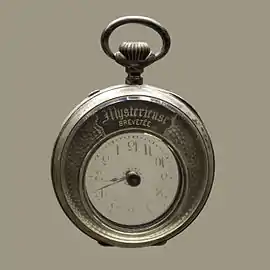Mystery watch
A mystery watch is a generic term used in horology to describe a watch whose working is not easily deducible, because it seems to have no movement at all, or the hands do not seem to be connected to any movement, etc.

One example is a type of mechanical watch where the movement is transmitted to the hands through a transparent crystal toothed wheel.
The first see-through watch, called in French montre mystérieuse (mysterious watch), was invented by Hugues Rime and marketed by the French firm Armand Schwob et frère. As an item of historical/horological value, it is preserved in various museum collections, such as the British Museum, the German Clock Museum, the International Museum of Horology, the Musée d'art et d'histoire de Neuchâtel, the U.S. National Watch and Clock Museum, and the Vienna Clock and Watch Museum.
